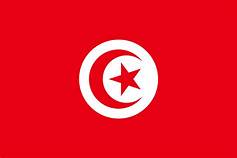
Tunisia
.
.
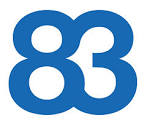
Trackchasing Country #83
Greetings from places on the way to and from Tunis, Tunisia. Click on the links below to read about the “story” and see the photos and videos from this trip to a place on the northern tip of the African continent, Tunisia, home to my trackchasing country #83.

I had some major concerns about trackchasing in Tunisia. I had been working on trying to confirm a race here for more than two years.
Here’s the deal. It’s pretty expensive to fly to a country nearly 14,000 air miles away round-trip. The cheapest airfares are nonrefundable. Before I can make a commitment and buy an airline ticket I have to be 110% sure there’s going to be a race on the other end of the trip.

The language of Tunisia is Arabic. As you might imagine I don’t speak Arabic. A good deal of Tunisians don’t speak much English. Therein lies the problem.
I needed to confirm that they would be having a wheel to wheel auto race on a road course, or an oval or a figure 8 track. In Tunisia, they do a lot of auto racing that is not “wheel to wheel”. This would include drag racing, drifting, hill climbs, karting and rallies.
I used all of my resources, and I have a lot of resources, to get a confirmation on the type of racing they would have and the actual race dates. Like I say I worked on this for more than two years. I could never really get the precise contacts that I needed that were in country.
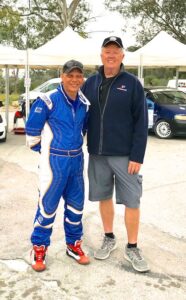
Then I met up with a fellow by the Facebook handle of “Slim Ab”. Slim was a Tunisian race driver. He and I corresponded with hundreds of messages before I made the trip. He was doing the best he could to help me.

I also met a young woman by the name of Lobna Bentbaya. She was very encouraging about my visit to her country, Tunisia. It was Lobna who put me in touch with a fellow by the name of Bassalah Dhafer. Are you getting the impression that Tunisian names are not exactly like American names? I guess “Randy” isn’t very common in Tunisia either!
Dhafer is one of the officials of the “Federation Tunisienne de L’Automobile”. I gave him a phone call. He spoke English well. Dhafer was able to confirm the type of racing they would be having and the actual race dates. When I finished my conversation with him I knew I was coming to Tunisia.
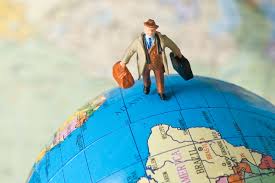
There are no direct flights between Los Angeles and Tunis, Tunisia. By the way, Tunis is the capital of the country. I booked my flight. On the way to Tunisia I would connect in Rome, Italy. On the way back from Tunisia I would fly to Paris, then Detroit and over to Los Angeles. As luck and circumstances would have it I only made it as far as Paris on the return trip. You’ll hear why that was the case a little bit later.
I wanted to make sure I had a nice place to stay in Tunisia. I was going to be there for six days. I selected the Sheraton Hotel. In advance of my stay they sent me an email asking if there was anything they could do for me to make my stay more pleasant.
Just for fun I sent a brief reply asking if they could give me the presidential suite. It you don’t ask you don’t get! The next day I received an email telling me that the presidential suite was occupied but that they would be sure to “take care of me”. I didn’t know what that meant but I would discover it when I arrived.
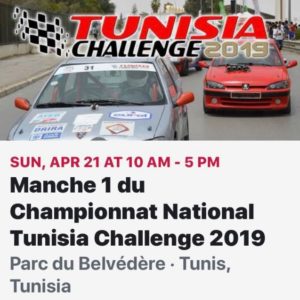
I had confirmation of the race date and the fact that they would be racing on a street circuit. I had my airfare booked and a great hotel reserved. I didn’t plan to rent a car. With the race being held on Tunis city streets and my hotel nearby I knew that at worst I could use taxis to get around.
As noted I was going to be in Tunisia for six days but the race was going to take place for just a few hours on one day. That would give me plenty of time to tour the country. That’s really what my trackchasing hobby is all about. It’s about meeting the local people and seeing the local sites. The race motivates me to travel to a country, but once I’m there people-meeting and sightseeing take precedence.
Carol would not be joining me in Tunisia. Tunisia was going to be my 83rd trackchasing country. Carol has seen racing in 47 countries and traveled to nearly eighty. She’s a pretty good little traveler in her own right. As a matter of fact, she was going to meet me in what would become the middle of my 19-day trip.
Without further ado let me tell you how this trip “came down”.
Wednesday, April 17, 2019.
Today Carol would drive me up to the Los Angeles International Airport. That way when she joined me later in the trip we would have only one car parked at the airport. We will return together and pick up the Carol Lewis owned and MFunds sponsored Lexus RX 350. We are very fortunate to have a very lucrative airport parking sponsorship program. It’s with LAX World Parking. We’ve been with them for more than 10 years. This saves me thousands of dollars every year.

I would be flying overnight on Alitalia Airlines from Los Angeles to Rome, Italy. That was a 12-hour flight. When I landed in Rome I would have a couple of hours to layover until I caught another Alitalia flight to Tunis, Tunisia.
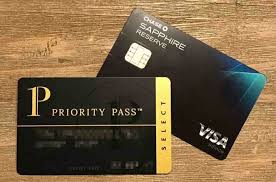
I often tell my readers that I couldn’t do this without my sponsorships. The Priority Pass program is one of my relatively new sponsors. PP allows me to stop in private airline clubs and airport restaurants all around the world. At the beginning of this trip I used the Korean Air Lounge and P.F. Chang‘s at LAX. Then I stopped at the Plaza Premium Lounge in Rome before finally visiting The Salon VIP Lounge in Tunis.
Unless you do a lot of long-distance and frequent travel like I do you might not appreciate how valuable a quiet peaceful place is that serves unlimited food and drink during each of my journeys. Priority Pass is one of the most valuable sponsorships I have.
I might also mention that I grew up in an era where there was no charge to check bags on airplanes. I guess that’s why I am so much against paying an airline to check my bag nowadays. On this trip I had an army field jacket that had its sleeves stuffed with travel gear. It weighed in at nearly 15 pounds. I also had a computer briefcase and a Costco rolling travel bag. Those two weighed another 25-30 pounds combined. It wasn’t that comfortable carrying all the stuff through the airports but at least I wasn’t paying an airline to check my bags!
Thursday, August 18, 2019
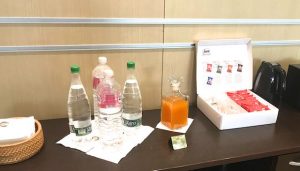
I landed in the Tunis Carthage airport in the late afternoon. My first stop was at the Salon VIP Lounge in the arrivals section of the airport. This was a very modest lounge by most accounts. Priority Pass has been sponsoring me for a little bit more than seven months. During that time I have used my restaurant privileges 89 times and airline lounges another 59 times. I’ve done that in 29 different airports. Yes, I do travel just a bit.
When I arrived at the Salon VIP Lounge I was asked for my passport. I gave it to them. They took my passport away for a few minutes while I enjoyed a drink. I didn’t really know what they were up to. I soon discovered the staff had made arrangements for me to clear border control through the “diplomats line”. There was nobody waiting in this line while the general purpose line was about 50 people deep. It was very nice of them to do and I am most appreciated their help.
I was just beginning to discover the tremendous hospitality of the Tunisian people. My advance contact, Slim Ab, lives in Sfax about 300 km to the south of Tunis had made some special arrangements for me. Slim is a member of the Master Racing Team. He had asked three of his team members to meet me at the airport.
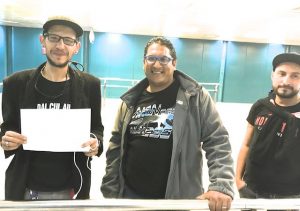
When I emerged into the general populace at the airport I soon found Amine (ah-mean), Anis (ah-niece) and Fay Cel (fy-sil) waiting to greet me. Over the next several days I would be getting to know these guys very well as well as their families. I was even invited into their homes.
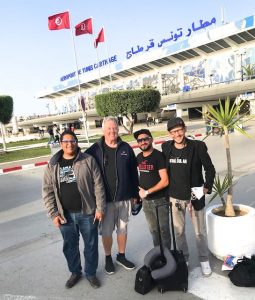
This threesome was as excited to meet me as I was excited to meet them. Everyone spoke English at different levels but we were able to communicate easily considering the vast differences in our geographical regions backgrounds.
My iPhone would not be working as a telephone while I was in Tunisia. AT&T doesn’t have that program set up here yet. Of course I would use my phone as a camera. When I was in the hotel I could use the hotel’s Wi-Fi for everything except making phone calls.
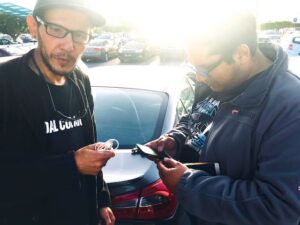
Can you imagine living the next six days of your life without your cell phone and the ability to make contact with anyone? Amine, Anis and Fey Cel had a solution to my communication dilemma. They were going to loan me one of their phones. They set it up and explained all of the details for me. This way I could get calls from them and they could get calls from me. Brilliant!
The guys drove me over to the Sheridan Tunis Hotel. It just turned out that they were good friends with the front desk clerk! I am a titanium elite member of the Sheraton frequent stay program. It’s called the Bonvoy program. I have no idea what “Bonvoy” means! Whenever I stay at a Marriott, Sheraton or Westin Hotels I get upgraded, usually to a suite.
Recall I had asked the hotel to give me the presidential suite upon my arrival. They didn’t do that but they did give me the diplomat’s suite. The hotel manager escorted me to my room. He explained this was the best room in their 267 room property. As I looked around I thought that it probably was.
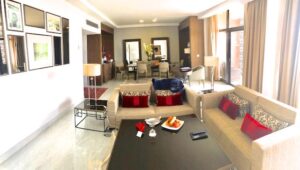
My hotel suite was probably more than 1000 ft.² in size. It had a huge balcony that ran the length of the room, probably a distance of 40 feet or more. The view of downtown Tunis was commanding.
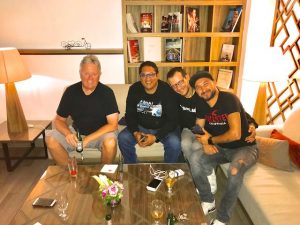
I would also have full privileges at the Sheraton Club while at the hotel. This gave me a complimentary breakfast each morning as well as hors d’oeuvres and cocktails in the evening and other refreshments throughout the day. I invited Amine, Anis and Fay Cel up to the club for a drink. This gave us just a little bit of time to get to know each other.
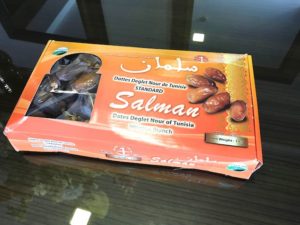
The fellas brought me a gift from Tunisia upon my arrival. It was a huge box of dates grown in Tunisia. What a nice gesture on their part.
Friday, April 19, 2019
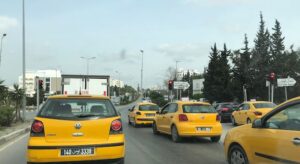
Today is going to be a full day of touring of Tunis. For the first half of the day I would be on my own. After breakfast I grabbed a taxi and went over to the Bardo National Museum. This was a highly-rated tourist activity by TripAdvisor but probably the least enjoyable of all of the things I did during my Tunisia touring. It was just a normal historical art museum. It was important to make a stop but after an hour or so there I had seen what I needed to see.
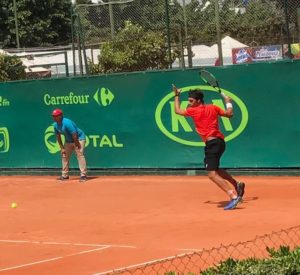
When I left the hotel this morning I noticed a sign advertising the “Tunis Open”, a professional tennis tournament. That sounded like something that I should be seeing. I grabbed a cab from the museum over to the tennis tournament.
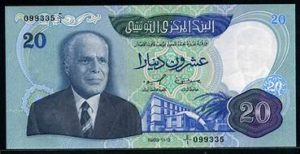
Later I would learn that the taxi driver ripped me off. I thought I had done everything to prevent that. I told the driver that he must use the meter. I figured if he did that I would get a fair price. I ended up paying about 25 Tunisian dinar when I should’ve paid three or four! By the way one U.S. dollar will buy about three Tunisian dinar. I guess I only lost about seven bucks on the transaction. Amine had a smile on his face when he explained that I had been “taken for a ride”.
At a little past noon Amine left work early and met me at the tennis tournament. He was going to be my guide for the rest of the day. Our first stop was at a Tunisian fast food outlet.
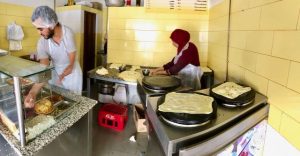
If you were imagining McDonald’s or In N Out Burgers…. stop right there. This was not anywhere close to an American fast food outlet. Nevertheless, they made me sort of a Tunisian style “burrito” which was delicious for not only its taste but for the Tunisian ambience provided.
I didn’t have a rental car and I didn’t have access to much electricity during the day. That was a problem for my camera, which is also my iPhone. If I’m actively using my phone and taking photos and videos at home the battery might last only three or four hours. Amine was a “tech geek“. He had a solution to my battery problem.
He told me that I needed a “power bank” that could provide me three or four charges for my phone. That would be more than enough for a full day of iPhone photography. I must admit that our son J.J. had recommended the same idea. However, when I’m home I’m either charging my phone in the car or at home. Despite the battery drain which is sometimes rapid I don’t really need a charger bank at home.
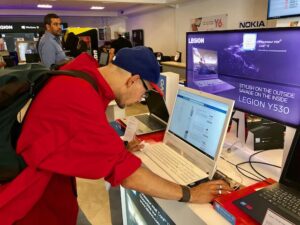
Amine had an idea on how we could get exactly what I needed. He did a little searching on his phone to find the right model, the right price and where we could buy it quickly. Then we went into the Tunisian equivalent of “Best Buy” and made the purchase. With Amine I had all of the capabilities of a local Tunisian while being only an English-speaking American.
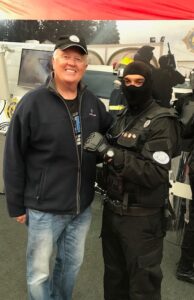
From there he and I went on a walking tour of downtown Tunisia. We saw the national theater and stopped in at a street side display featuring the BAT organization of Tunisia, which is similar to our SWAT team. We followed that up with a stop at a local bar for some beers. We ate olives and breadsticks and enjoyed each other’s company.
Tunisia has a population that features the Muslim religion for 98% of its residents. I’ve been in several Muslim countries including Saudi Arabia, Maldives, Qatar and the like. Of all the Muslim countries I have visited the outer dress of the Muslim followers is the least pronounced in Tunisia. What I mean to say is their religion is kept in the background as religion is in most parts of the world.
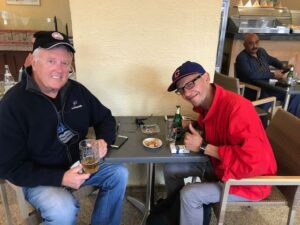
I didn’t hear many announcements over the PA system coming from the mosques during prayer time which occurs five times each day. A few of the women were wearing hijabs but not all that many. I was also able to have a beer here and there with the fellows from the Master Racing Team.
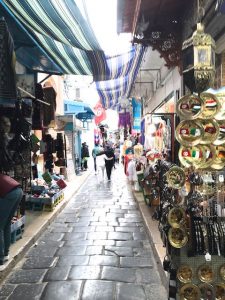
The final stop of our touring day was over to the Medina section of Tunis. This is what would also be called “old town”. Medinas in the countries that I have visited are some of the most unique spots in these older cities. Of course they are tourist traps as well. Nevertheless, they are fun to see.
When I go on trips like this I’m certain to buy special local presents for Carol. They need to be small and as lightweight as possible since I normally don’t have any more space to pack things I might buy.
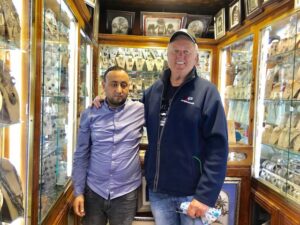
Today Amine hooked me up with a silver dealer. One of Amine’s family members had a shop right across the way from the silver dealer. This helped us get a good price on a high-quality silver necklace and bracelet for Carol. I think she’s going to love it.
From there Amine took me all over the old town area. We stopped and bought some sweets that were local Tunisian favorites. Then Amine asked me to join him for a special coffee offered only in the Medina.
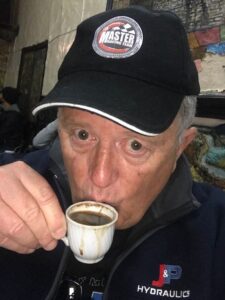
I am not a coffee drinker. Typically I might have one cup of coffee or maybe none in an entire year. However, today’s coffee was served in a very small cup and tasted somewhat chocolatey. I liked it. Amine had to remind me that I will shouldn’t consume the half inch of coffee grounds left in the bottom of the cup!
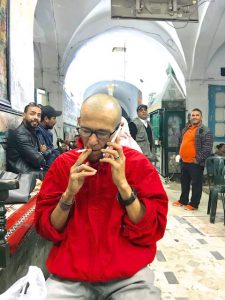
I must point out that the Tunisian men that I hung around with during this trip were heavy smokers. They were either smoking real cigarettes or vaping. I’m going to guess some of these young fellows smoked two packs a day or more. It’s not my place to judge but I don’t want any of my friends suffering the health consequences that might come from smoking.
You might think that I had already had a pretty full day of visiting, Tunis, Tunisia. I had but we weren’t done yet. Amine and I grabbed a taxi back to the hotel. I was given an hour break and then Amine and Anis were back to take me out to dinner.
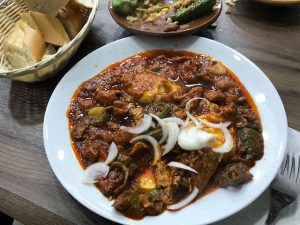
Every one of the places that we dined at during the trip were informal places and nothing like you might imagine if you come from America. They took me to one of their special places where a special dish of vegetables, meat and eggs were cooked up in a large cake pan of sorts. Then everyone at the table grabbed pieces of bread and dipped the bread into this concoction. We all ate from the same bread pan. It was spicy and good.

Following dinner Amine, Anis and I went to have some ice cream. This might’ve been the most “normal” shop by my cultural standards. We ordered our ice cream and then had liquid white and dark chocolate drizzled around our serving. The ice cream was great being able to enjoy it with my two new friends made it extra special.
Saturday, April 20, 2019
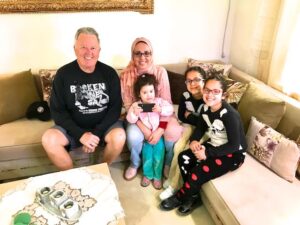
Race day is tomorrow. However, today was going to be a very busy day much of it racing related. Anis picked me up at the hotel and we made a stop at his house. There I got a chance to meet his lovely wife Asma as well as their three daughters. They have eight-year-old twins as well as a three-year-old. They were all delightful.
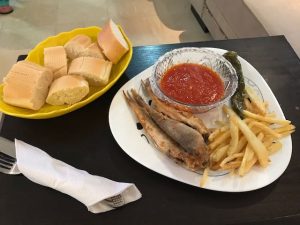
I often say that you don’t really have a friend unless you have played a round of golf with them or shared a meal with them or been invited into their home. Anis and Asma not only invited me into their home but Asma prepared lunch for me in their living room. A highlight of the trip was being invited into their home and meeting everyone in a native Tunisian family.
From there Anis and I hopped into his Mercedes and stopped at a local bakery. Anis likes to eat as I do. We enjoyed a very delicious Tunisian pastry. From there we made our way over to the home of his parents and brother.
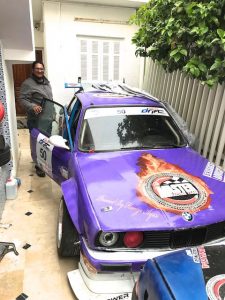
Anis keeps his circuit racing car, his drifting car (above), his motorcycle and his dune buggy at his parent’s house. I got to meet everyone in the family as well as visit the sound studio where Anis practices his DJ work.
After we had seen all of that we headed over to the Master Racing Team garage. Here is where they work on the cars they will race for tomorrow’s circuit racing. Right now they have three racers competing on the team but expect to have as many as seven or eight sometime during this year.
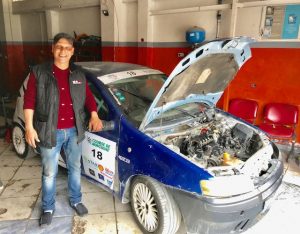
It was here that I got to meet Slim Ab for the very first time. Slim and I had been communicating via Facebook Messenger for a few months. He really hung in there with me to make sure that I got all of my questions answered and that I was going to have a good visit to Tunisia.
Slim and his family live about 300 kilometers to the south of Tunis. They had made the drive up to Tunis this morning from his home city of Sfax. Slim’s wife and brand new baby girl were joining him for the racing weekend.
Slim was happy to see me. He was just about the most smiling and congenial guy I’ve ever met. I handed him a large bottle of vodka that I picked up at duty-free in the airport. I was hoping the team could celebrate their successes later in the weekend with it.
If you are a race fan I don’t know if you’ve ever hung around the garages of racers. As a young boy I used to do that in East Peoria, Illinois. There were about 10 homes on my block. Three of them were home to stock cars! That’s how I developed my love for short track racing.
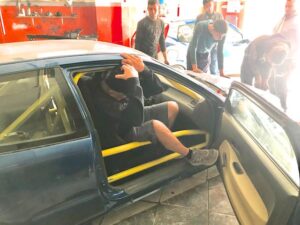
Today I hopped (O.K. squeezed!) in a couple of the race cars, on the passenger side, and went out onto the city streets so that we could test the car’s brakes and steering. I rode with Anis for more than 10 miles along city streets as we headed over from where he keeps the car to the Master Racing Team garage. These guys like to drive fast and tailgate on city streets! Although it was pretty snug for me to even get in the race car we did all of this without seatbelts!
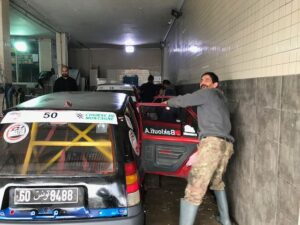
The guys did do something with the race cars that I never would have expected. They took them to a car wash! For about three dollars U.S. the cars were washed and cleaned both outside and in. Nope. I never would have expected that.
The next item on my daily agenda wasn’t expected either. Anis is involved in different elements of city planning. He had a meeting to go to and invited me to join him.
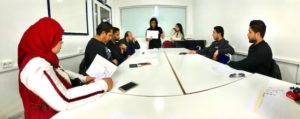
For the next 90 minutes I sat in a conference room while a young woman used a whiteboard to explain their plans. Of course, the entire meeting was done in Arabic. I had absolutely no idea what they were talking about! Nevertheless, I paid attention as if I knew what was going on even though I didn’t.
It was getting dark and late in the day. We were going to have dinner later but Anis asked me if I was hungry. Actually, I was. Anis had a solution for that.
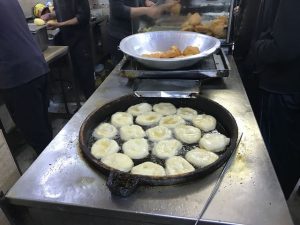
We stopped at a local place that was serving fricassee. Fricassee is a Tunisian sandwich of sorts. They take raw dough, throw in hot oil and it fries up into a bun in 30 seconds or less. The bun is then cut in half and stuffed with vegetables and meat.
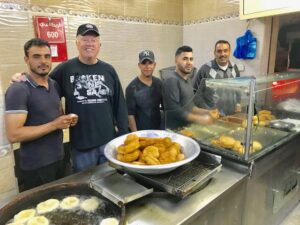
I must tell you that this is a place that on my own I would never considered stopping in. It was night time. The area looked a little rough by American standards but I never really felt danger at any point during this entire trip. With Anis as my “bodyguard” I knew that I was safe. I just enjoyed the local scene, which virtually no American will ever get to encounter. I was privileged and thankful.
It was about this time that Anis got a phone call. His wife Asma wasn’t feeling well. We needed to come home and see if we could take her to a doctor or get her medicine. I had just seen Asma a few hours ago and she was feeling fine. Now she wasn’t. We picked her up and then stopped at a local healthcare clinic. They referred us to a doctor. We sped on down the road until we reached the doctor’s office, which was located in a residential home. From their Asma was diagnosed and we picked up some medicine for her at the local pharmacy. This was definitely an element of local life that happens but that I have never been exposed to it previously in any of my foreign visits.
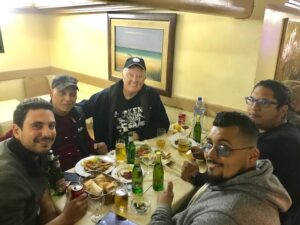
Next up was a dinner with some of the guys at an all-male restaurant/bar. Here we drank beer and just relaxed and shared some stories. One of the guys, who spoke English very well, told me he had never ever spoken to an American before! Slim ordered a full fish, including head and eyes for me. That is definitely something I don’t eat at home. Nevertheless I tried to “go with the flow” and the white meat I picked off the fish was actually pretty tasty. I still didn’t like that dead fish staring up at me!
Today had been another full day of touring and meeting people. Tomorrow is race day. I’m looking forward to that. So far the trip to Tunisia has easily met and exceeded my expectations. I couldn’t have expected more. The hospitality of Slim, Anis, Amine and Asma was well over bit over the top.
Sunday, April 21, 2019

Today was race day! Remember, it was the race that brought me to Tunisia. In some ways the racing today was actually anti-climactic and took second place to all of the experiences I had during the first three days of the trip as well as what I would do tomorrow. Nevertheless, it was going to be fun to see racing in my 83rd different country.
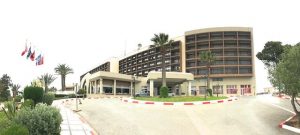
My hotel was situated only about 200 meters from the Belvedere Circuit. They’ve been racing here since the 50s. This is a street course in the city of Tunis. The local government simply shuts down the road for a few hours when the race is going on.
I actually walked from the hotel to the paddock this morning. It was cloudy but with no real chance of rain. The temperature was in the 60s most of the day.
I had already taken a couple of laps around the track over the past couple of days in a passenger car. Anis was nice enough to be my chauffeur. The track runs in a clockwise direction for a distance of nearly 3 km. There are significant elevation changes in the course as well.
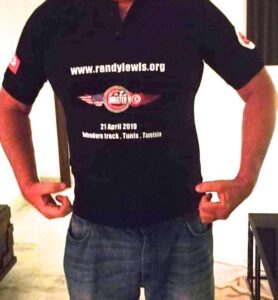
I must tell you that the Master Racing Team, lead by vice president Amine, created a beautiful event golf shirt for me. They developed a fantastic logo that merged the flags of the United States and Tunisia together. I didn’t wear the shirt to the races today. Why not? Well it seems like an XXL in Tunisia is not an XXL in the U.S.! It was a bit too small but it’s a souvenir T-shirt that I will value forever. Thank you Amine and the Master Racing Team.
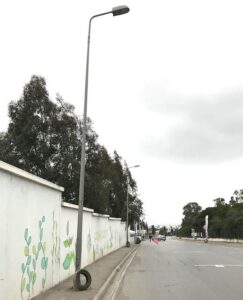
The safety barriers around the Belvedere Circuit were on the lax side. If you check out my photos you will see a single tire as the safety barrier protecting some rather large light poles and other fixed objects. There was a good deal of steel Armco barriers about 2-3 feet high. Fans moved all around the course trying to get a good view. In some cases there wasn’t much separating the racing fan and the racing car.
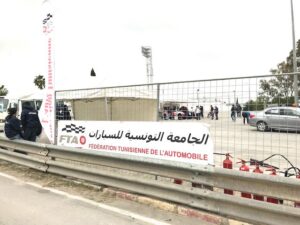
The Federation Tunisienne De L’Automobile sanctions these races. They also sanction other kinds of motorsports in Tunisia such as drifting and drag racing.
There were only eight racecars in the paddock today. This was the first circuit racing event of the season. Amine told me they expect to have several more cars appear before the end of the year.
I very much appreciated getting the opportunity to ride in the safety car for a full lap around the track this morning. I’ve done that a few times at other raceways. It’s a very eye-opening experience and again something that most race fans will never get a chance to do.
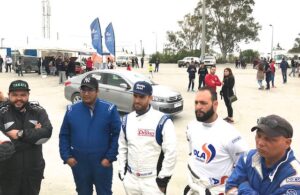
I attended the drivers’ meeting. Again because it was conducted in Arabic I had no real idea what was being discussed.
I did know this. They would have four qualifying races and a main event. If a driver won a qualifying race they received one point. The driver to finish last or in eighth place would get a score 8 points. Just like in golf the lowest score would win today.
There was no admission charge for fans today. There were also no concession stands or food operators. As a matter of fact, I didn’t even notice any bathrooms anywhere around the paddock. They did have a DJ who played some really good music over some stout speakers. That livened up the atmosphere.
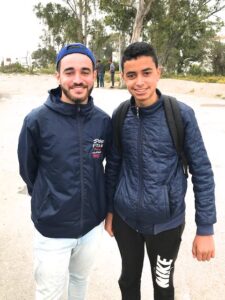
I hung around the pit area talking with members of the Master Racing Team. I also spent some time with a young fellow by the name of “Iheb” (above left). He was wearing a Kansas City Royals hat. During the day he and I had several conversations. I learned he had been an exchange student in Warrensburg, Missouri. He also got to travel around the United States a bit during his stay in America. It was fun talking to him because he had experiences both in Tunisia in the United States.
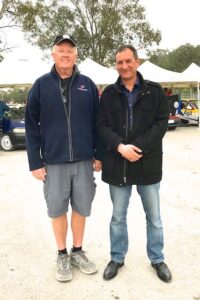
I also had a chance to meet with the Federation racing president, a fellow by the name of Hatem. He was a great source of information. Hatem was also pleased that I had come all the way from my home to see racing in his home country.

It was fun meeting Lobna Bentbaya just briefly. Lobna had been very instrumental in allowing me to confirm the details of this race when she referred me to Dhafer another leader in the racing Federation.
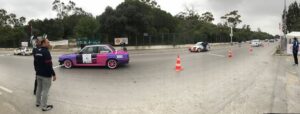
Like most street courses it was somewhat difficult to see the racing action. At pretty much the beginning of each race I stationed myself in a different position. I started out watching the race from the start/finish line of the paddock. Then I moved down about 800 meters to where there was a sharp right hand turn in the course. There was a lot of action here. Finally I went with a friend to the backside of the course where they really ran some fast times. They were parts of the course where viewing opportunities were almost nonexistent.
I’m going to ask that you take a look at my video as well as pictures from the race action today. They will give you a good idea of the type of racecars competing today as well as how the entire scene unfolded.
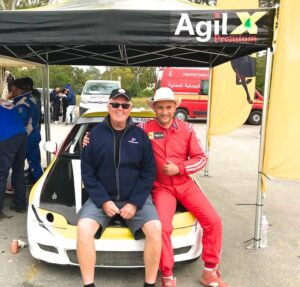
One driver by the name of Walid Maazooz dominated today. His sponsor Agil X a fuel company was prominently displayed on his race car. He definitely had the field covered. I had a chance to meet him. We talked briefly. Walid seemed like a real nice guy.
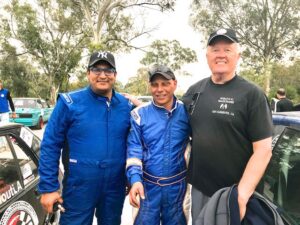
My guys with the Master Racing Team didn’t do as well as they were hoping to do. Nevertheless, they gave it all they had. MRT vice president Amine has some very creative plans for future races. We will see how that works soon.
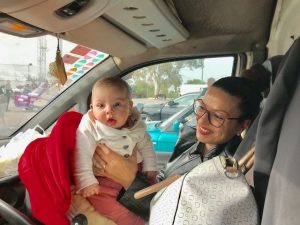
When the races were over I did get a chance to meet Slim Ab’s wife and baby daughter. They stayed in the comfort of their car while most of the race thing was going on. It’s always fun to meet the families who support the racers.
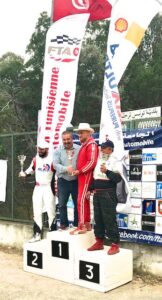
When all of the races were finished they had a podium celebration. This recognized the drivers that finished in the first three positions overall for the day. Everyone in the paddock gathered together to give a round of applause for today’s winners.
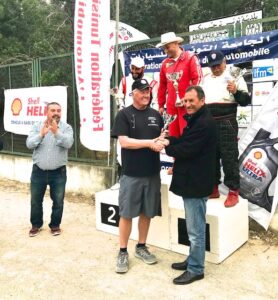
I was in for a major surprise, which I had not seen coming. They asked me to come up on the podium and accept a trophy for being the World’s #1 Trackchaser and coming all the way from the United States to Tunisia. It’s a beautiful piece and will go in my trophy room and be admired forever. Thank you Federation Tunisienne De L’Automobile and everyone who helped out.

Following the races the entire team headed over to Anis’ home. There Asma and her mother would prepare a Tunisian feast for the Master Racing Team. Mind you this was the same woman who we had taken to the doctor’s office late last night. Thankfully she was feeling much better today and her hospitality for the team was appreciated by everyone.
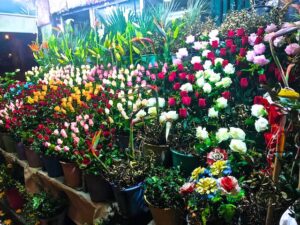
Later I got the chance to partially re-pay Asma for all of the work that she and her family had done. On the ride back to the hotel I asked Anis to stop at a flower stand. Asma and I stepped out of the car. She picked out a beautiful bouquet of assorted roses. for her and her family to enjoy. What a nice lady.
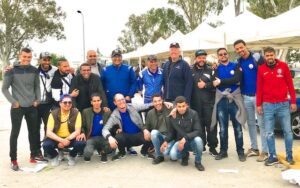
The Belvedere Circuit in Tunis, Tunisia will forever be known as lifetime track #2,547. Tunisia will be lifetime trackchasing country #83. I couldn’t be more pleased with the results of the racing action today. Major thanks to the Master Racing Team for everything they did to make my visit a great one. I’ve still got another day of touring before I head off to Paris for a couple of days.
Monday, April 22, 2019
I had one more full day on this trip to see Tunisia. Different people had been recommending some places that would make my touring day a good one. One of the guys with the Master Racing Team was scheduled to pick me up and do some of the navigating. However, he went down with a broken hand.
One of the things that I pride myself on when I’m traveling is being flexible. I always have a plan. The plan has a current best idea. However, when the current best idea gets trumped by an even better current best idea I’ll change on a dime. That’s what I would do this morning.
I hired a taxi for 60 dinar to take me around to see the sights for a couple of hours. That would cost me about 20 bucks U.S., which I thought was more than reasonable.
The Sheraton hotel concierge told me he would get me an English-speaking taxi driver. When people tell me specific things that appear to be fact I always believe them. I guess I’m kind of gullible in that regard. I know that when I tell someone something they can take it to the bank. The reverse of that doesn’t always happen.
My taxi driver spoke very little English! Nevertheless, we were only going to see three sites and they were all pretty close together. I figure we could work it out.
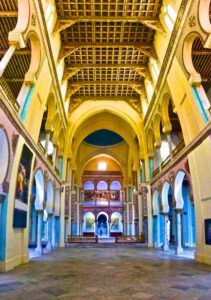
My first stop was the Acropolium, which is also known as the Saint Louis Cathedral in Carthage, Tunisia. This was a Roman Catholic cathedral although it is no longer used for worship. It does host public events and concerts. Don’t miss the photos from this brief visit. I don’t know that I’ve ever taken more artistic photos with my iPhone at any place I have visited.
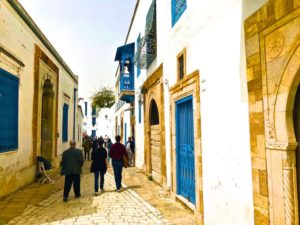
Just a few kilometers down the road was a place called Sidi Bou Said. Everyone to a person told me that I couldn’t miss this place. The town itself is a tourist attraction and known for its extensive use of blue and white. It is definitely a town of artists. Again don’t miss the photos.
A highlight was having a donut fried up in front of my eyes. That donut was then doused with sugar and downed by me with some dispatch. It’s all part of the fun.
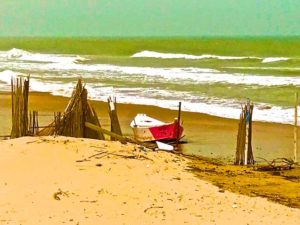
My last stop with this tour was to Marsa Beach. It was a cool and cloudy day so not much of a beach day. However, I can at least say I made the stop. I was back to the hotel by noon.
The racing weekend was finished. All of the guys with the Master Racing Team were at work today. However, Amine and I were contacting each other frequently via Facebook Messenger. He had another touring idea for me in the afternoon.
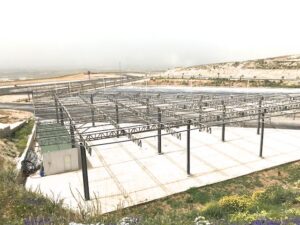
There is a special project being built just outside the city of Tunis. It’s the “Tunisia First Club” project. It’s a massive complex, by Tunisian standards, which will feature a brand new road course suited for motorcycles and cars as well as all kinds of other tourist activities for the outdoors person.
Amine arranged for one of the PR representatives from the project to pick me up at the hotel. We drove out to the construction site. Soon I was meeting an entrepreneur by the name of “Lootsy” and his construction manager, Bob.
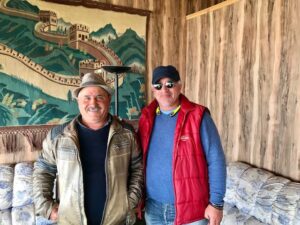
Lootsy (above left) didn’t speak much English. Bob (above right) acted as our translator. They showed me around the project including the villas, which are being constructed for overnight guests.
In some situations this might have been a 10-15 minute visit to see the construction project and ask a question or two. It turned into something entirely different.
For the next two hours the three of us sat in one of the villas chewing the fat. This was a different kind of fat to chew. I spoke only English. Lootsy spoke only Arabic. Bob was the ping-pong ball in the middle translating the entire two hour’s worth of conversation.
Lootsy is a 52-year-old entrepreneur. Like most entrepreneurs I have ever met his life revolves around work. He couldn’t fathom the idea of retirement at this stage in his life. He wants to build this project and then will be looking for the next project to take on.
My working life was as a “corporate man”. I wanted to do a good job and get rewarded for it as handsomely as I could. Nevertheless, my eye was always on the prize at the end of my working career… retirement. I never took my eyes off of the end goal. When I thought I had enough money to live the rest of my life without working I retired at the age of 52.
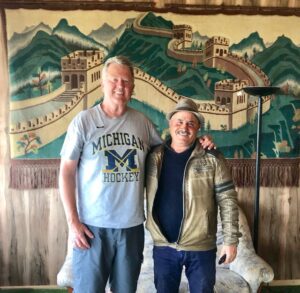
I explained some of my financial strategies to Lootsy. He was intrigued, which is what kept the conversation going for so long. It was fun for me to explain a lifestyle concept have it translated and then have Lootsy ponder the thought for just a moment and have a wry smile come across this face when he got the meaning. These two hours were some of the best that I spent during the entire trip with anyone.
Earlier in the trip I had joined Anis at a city planning meeting. I hadn’t really known what we were getting into and ended up sitting with about 10 of the city planners for a 90-minute Arabic only language meeting. Something similar to that happened tonight.
Tonight Amine and I made arrangements to go out with some of the guys for dinner. It was my last night in Tunisia. What I didn’t know was that this dinner was actually an impromptu meeting of eight of the members of the Master Racing Team. It was kind of their debrief from the weekend of racing.
I will tell you this. All of these guys are in the age range of 25-40. They smoke a lot. Have you ever been around folks that smoke a lot? I haven’t for a very long time.
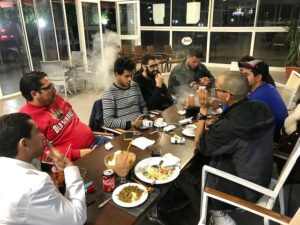
Nevertheless, while they vigorously debated whatever it was they were talking about in Arabic for THREE hours, I chowed down on some pasta, olives and a chocolate milkshake. Again I had no idea exactly what they were talking about. I did know this. They were very passionate about whatever the subject was!
The meeting wrapped up only when the restaurant was closing and removing all the chairs and tables from the outside deck where we had spent the last few hours. If the restaurant hadn’t closed I’m not sure how long the meeting would have gone on.
This was the last time I was going to see members of the Master Racing Team at least on this trip. Amine and Anis and I talked about going to see some racing in another African country. I don’t know if we’ll do that but I hope that we will. I bid a fond farewell to all of the really great Tunisian friends I had met over the space of the last five days. It turned out to be a wonderful trip and the people I met made it so.
Tuesday, April 23, 2019
It was time to leave the special digs I had for nearly a week at the Sheraton Tunis hotel. I would be taking a cab from the hotel to the airport. Believe it or not the 10-15 minute ride cost only about one dollar U.S. I’m not sure I’d ever ridden in a cab that inexpensively before.
I had an airline ticket that would take me, if I chose to use it this way, from Tunis to Paris to Detroit to Los Angeles. However, my plans had changed since the time that I had purchased this airline ticket.
Today I would ride from Tunis to Paris and that was it. I was getting off in the Charles de Gaulle airport. Why would I give up an airline ticket that would bring me all the way home that I had already paid for? Good question.
About three weeks ago I had planned to go to what would have been trackchasing country #83. However, their weather forecast was so questionable that it didn’t seem prudent to make that particular trip. When I didn’t go there Tunisia became trackchasing country #83.
Now that track and country that had such bad weather three weeks ago was going to be running this coming Sunday. Since I was already out in this part of the world wouldn’t be a good idea if I just stayed over for another 10 days or so and saw that race in what would now become country #84 for trackchasing purposes? I thought that was an excellent idea.
As a matter of fact, after I discussed the situation with Trackchasing’s First Mother, that would be wife Carol, she thought she would get in on some of the fun. Later this week she and I would meet at an as yet undisclosed European country. As an avid reader of my Trackchaser Reports you’ll hear about all of that soon.
As it was I would fly to Paris this morning and stay there for two evenings. I would do a little bit of touring in Paris itself as well as meet a fellow who is originally from Tunisia and was now living in Paris. That would be Fahem Mohamed Ali. He wanted to do a video interview about my experiences at the Belvedere Circuit in Tunisia. That sounded like fun.
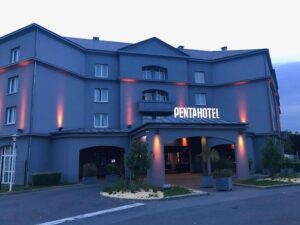
My flight from Tunis to Paris was unremarkable. Downtown Paris hotels can rent for $300-$400 a night and more. At the same time I could get a very nice and comfortable modern hotel somewhere near the airport for about $75. That’s what I chose to do.
When I landed I simply hopped on a black airport bus that took me at no charge from the airport to my hotel about 10 miles away. The hotel was located in a very small French town. It couldn’t have been any more picturesque if it had been painted by Norman Rockwell. The hotel was fantastic.
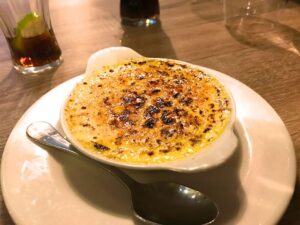
In the evening I consulted Yelp, my restaurant identifier of choice iPhone app, and found a place within a 500 meter walking distance of the hotel. I walked over there and enjoyed a couple of escargot and garlic butter appetizers and a dessert of crème brûlée. If someone can eat escargot and crème brûlée in France in a relaxed atmosphere they should do it.
Wednesday, April 24, 2019
Today I rode the bus from the hotel to the airport and then took a train into downtown Paris. It’s fun taking public transportation when you grow up in a small town and live in a suburban beach community. We don’t use a lot of public transportation in California. However, today it worked out nicely.

I had thought about taking Uber from my hotel to downtown Paris. However, that would have cost me €38 one-way. The round-trip train from the airport at the Paris fair was only about €15.
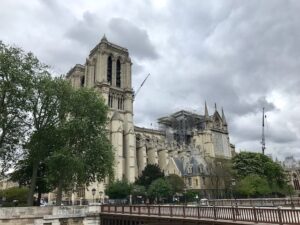
My first stop on my tour of Paris was at the Notre Dame Cathedral. You certainly know that it suffered a major fire less than two weeks ago. You won’t want to miss my photos of the cathedral.
I stopped along one of the Paris streets and ordered a chocolate Nutella crêpe. It was delicious. Then I hopped on a Big Bus sightseeing tour that would take me around to the major sites of Paris.
I’ve been to Paris many times. As a matter of fact, in about 1973 Carol and I went to Paris for the very first time. At the time the Holiday Inn hotel chain had a special year-long promotion going on.

If I stayed in a Holiday Inn for 75 nights during the year they would give me round-trip airfare for two and a week’s hotel anywhere in the world. I did just that and soon Carol and I were heading off to Paris to stay in a Holiday Inn!
Here’s one of the funny things about that promotion. Back in 1973 the Holiday Inns I was staying in only cost about $30-40 per night. That meant that if I paid $40 for 75 nights at a Holiday Inn I was only spending $3,000. What did I get for $3,000?
First I got to stay in a Holiday Inn on business for 75 nights in the United States. Yes, the company picked up the entire tab for all of those 75 nights. Then Holiday Inn gave me two round-trip airfare tickets from the United States to Paris as well as a week’s hotel in downtown Paris. That was a pretty good promotion… for us.
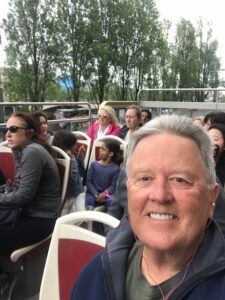
I love using the “hop on hop off” touring idea. It’s a great way to see a number of sites in a short period of time. If you like something you can get off the bus check everything out and then board the bus when you’re finished.
Today’s 24 hour availability bus ride cost me €40. This also included a one-hour boat ride around Paris on the river Seine. I thought it was a great value considering the high cost of Paris.
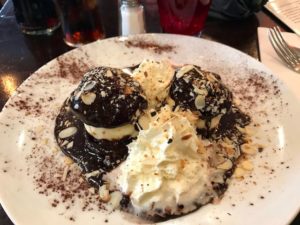
Later in the afternoon when I have completed one circle around Paris I stopped at a café. There I had a bottle of Coke Zero and a special ice cream and chocolate dessert for the princely sum of about 15 bucks. Yes, Paris can be expensive.
Next, I was in for a special treat. I would be meeting with Fahem Mohammed Ali who hails from Tunisia but has been working in Paris for about a year. He’s a former driver on the Tunisian racing circuit. He actually sold his cars to my friend Anis. Fahem Mohammed was going to be interviewing me regarding my recent visit to his home country.
He and I messaged back-and-forth until we met up near the Bulgarian Embassy in Paris. We soon found a restaurant. While he set up his video gear we ordered dinner. I went with a very delicious risotto.
It was fun answering Mohammed‘s questions. He sent me a completed version of the video about 10 days later. You’ll find it in the video section of this Tunisia Trackchaser Report. I hope you like it.
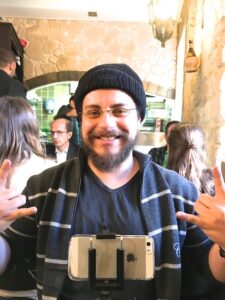
It was also interesting, fun and educational to talk with Fahem Mohammed on personal subjects. He had some very interesting comments to make regarding the discrimination that he had faced while living in France based upon his religion. There certainly is a lot of discrimination that goes on for all kinds of reasons in all kinds of places all around the world.

Fahem Mohammed and I bid each other farewell at the base of the Eiffel tower. I had a most enjoyable experience meeting with him and wish him the very best for his future here in France.
Then I hopped on the train and rode it back to the Charles de Gaulle airport. There I switched to my bus that would take me over to my hotel for my last night in France.
Thursday, April 25, 2019
The “Tunisian” part of my trip was now ending. This morning I would fly from Paris to Zagreb, Croatia. I had a good friend of mine who lives in Luxenberg but whom I first met in Bosnia-Herzegovina, his home country. Boris would be picking me up at the airport. Later in the day Carol will be arriving from Los Angeles via Vienna, Austria into the brand new Zagreb, Croatia airport terminal.

I think I know what you might be thinking. You’re thinking that Carol and I are a world jet setting couple. Well, if that’s what you are thinking I’m not sure I can provide enough facts to dispute your point of you.
I hope you get the impression that I had a perfectly wonderful time during my visit to Tunisia. I began this report by saying I was a little concerned about how this trip was going to go. I shouldn’t have been. Once I arrived in Tunisia the people I met made sure I was going to have a safe, enjoyable and most entertaining visit to their country. Tunisian hospitality is outstanding.
Good day from Tunisia and other points involved in the trip.
THE COUNTRY LIST
#83!!
RLR – Randy Lewis Racing Lifetime Trackchasing Countries
# 1 – UNITED STATES OF AMERICA– Peoria Speedway – Mt. Hawley, (oval) – Track #1, Peoria, Illinois – circa 1954 (age 5)
# 2 – CANADA– Cayuga Speedway (oval) – Track #174, Nelles Corner, Ontario – July 31, 1988 (Dick Trickle winner)
# 3 – AUSTRALIA– Parramatta City Raceway (oval) – Track #180, Granville, New South Wales – November 17, 1989 (accompanied by Carol)
# 4 – UNITED KINGDOM– Northhampton International Raceway (oval) – Track #378, Northhampton – June 26, 1999 (accompanied by Carol, Kristy, Jim)
# 5 – NETHERLANDS– Driesum Racetrack (oval) – Track #839, Driesum – May 5, 2005 (accompanied by Roland Vanden Eynde)
# 6 – BELGIUM– Bellekouter oval (oval) – Track #841, Affligem – May 8, 2005 (accompanied by Roland Vanden Eynde)
# 7 – FRANCE– Circuit de Croix en Ternois (road course) – Track #843, Saint-Pol sur-Ternoise – May 8, 2005 (accompanied by Roland Vanden Eynde – 2ndnew country in one day!)
# 8 – GERMANY– Nurburgring (road course) – Track #844, Nurburg – May 13, 2005 (accompanied by Carol, Roland Vanden Eynde)
# 9 – NEW ZEALAND– Western Springs Speedway (oval) – Track #1,134, Western Springs – December 26, 2006 (accompanied by Carol)
# 10 – MEXICO– Triovalo Bernardo Obregon (oval) – Track #1,281, Tiajamulco de Zuniga, Jalisco – October 14, 2007 (accompanied by Carol, J.J., Roger Ward)
# 11 – BARBADOS– Bushy Park Racing Circuit (road course) – Track #1,296, Bushy Park – December 9, 2007
# 12 – THAILAND– Bira Circuit (road course) – Track #1,300, Pattaya – January 19, 2008
# 13 – SOUTH AFRICA– Durban Grand Prix (road course) – Track #1,315, Durban, KwaZulu-Natal – February 24, 2008 (accompanied by J.J. and Will Van Horne)
# 14 – JAMAICA– Dover Raceway (road course) – Track #1,322, Brown’s Town St. Ann – March 24, 2008
# 15 – SWEDEN– Sturup Raceway (road course) – Track #1,335, Malmo – May 10, 2008 (accompanied by Carol)
# 16 – DENMARK– Ring Djursland (road course) – Track #1,336, Tirstrup – May 11, 2008 (accompanied by Carol)
# 17 – CZECH REPUBLIC– Automotodrome BRNO (road course) – Track #1,381, Brno – September 13, 2008
# 18 – AUSTRIA– Lambrechten Stock Car Track (road course) – Track #1,382, Lambrechten – September 14, 2008
# 19 – IRELAND– Tipperary International Raceway (oval) – Track #1,388, Rosegreen – October 26, 2008 (Carol and I visited this track earlier in the year)
# 20 – GUYANA– South Dakota Circuit (road course) – Track #1,390, Timehri – November 2, 2008 (accompanied by Carol)
# 21 – CHINA– The Guia Circuit (road course) – Track #1,392, Macau – November 16, 2008 (accompanied by Carol)
# 22 – COSTA RICA– Autodromo La Guacima (road course) – Track #1,398, La Guacima – November 30, 2008
# 23 – ANDORRA– Grandvalira Circuit (road course) – Track #1,404, Port d’Envalira – January 17, 2009
# 24 – ARGENTINA– Circuito Efren Chemolli (oval) – Track #1,406, Buenos Aires – January 31, 2009 (shared with Jerry Fisher)
# 25 – QATAR– Losail International Circuit (road course) – Track #1,408, Doha – February 13, 2009
# 26 – BAHRAIN– Bahrain International Circuit (road course) – Track #1,410, Sakhir – February 27, 2009 (accompanied by Carol)
# 27 – UNITED ARAB EMIRATES– Dubai Autodrome (road course) – Track #1,411, Dubai – February 28, 2009 (accompanied by Carol)
# 28 – COLOMBIA– Autodromo de Tocancipa (road course) – Track #1,415, Tocancipa – March 22, 2009
# 29 – SPAIN– Motorland Aragon (road course) – Track #1,416, Alcaniz – March 28, 2009
# 30 – PORTUGAL– Circuto de Murca (road course) – Track #1,417, Murca – March 29, 2009
# 31 – ICELAND– Kapelluhraum (road course) – Track #1,420, Hafnafjorour – April 25, 2009 (shared with Will White)
# 32 – HUNGARY– Hungaroring (road course) – Track #1,426, Mogyorod – May 8, 2009 (accompanied by Carol)
# 33 – SWITZERLAND– Hock Ybrig (road course) – Track #1,427, Hoch Ybrig – May 9, 2009 (accompanied by Carol)
# 34 – ITALY– Vighizzolo d’Este Stock Car Track (road course) – Track #1,428, Vighizzolo d’Este – May 10, 2009 (accompanied by Carol)
# 35 – DOMINICAN REPUBLIC– Autodromo Mobil 1 (road course) – Track #1,515, Santo Domingo – December 6, 2009 (accompanied by Carol)
# 36 – MALTA– Ta’Qali Race Track (road course) – Track #1,521, Ta’Qali – February 7, 2010 (accompanied by Carol)
# 37 – FINLAND– Lake Pidisjarvi Ice Track (road course) – Track #1,524, Nivala – February 20, 2010
# 38 – JAPAN– Suzuka Circuit (road course) – Track #1,530, Suzuka – March 21, 2010
# 39 – CHILE– Autodromo de Interlomas (road course) – Track #1,531, Temuco – April 18, 2010
# 40 – MOROCCO– Circuit de Marrakesh (road course) – Track #1,535, Marrakesh – May 1, 2010 (accompanied by Carol)
# 41 – BRAZIL– Circuit de Caruaru – Aryten Senna (road course) – Track #1,540, Caruaru – May 16, 2010 (accompanied by Carol, Jerry Fisher and Katina Spencer)
# 42 – ESTONIA– Laitse Rally Park (road course) – Track #1,571, Laitse – July 24, 2010 (accompanied by Carol)
# 43 – LATVIA– Bikernieki (road course) – Track #1,572, Riga – July 25, 2010 (accompanied by Carol
# 44 – GUATEMALA– Autodromo Pedro Cofino (road course) – Track #1,580, Alotenango – August 15, 2010
# 45 – EL SALVADOR– El Jabali (road course) – Track #1,582, Quezaltepeque – August 22, 2010 (accompanied by Carol)
# 46 – ROMANIA– Bradu (road course) – Track #1,603, Bradu – October 16, 2010
# 47 – BULGARIA– Closed Route – Burgas (road course) – Track #1,604, Burgas – October 17, 2010 (accompanied by Lyubomir and Plamen Simeonov)
# 48 – SOUTH KOREA– Korea International Circuit (road course) – Track #1,605, Yeongam, Jeollanam-Do – October 24, 2010
# 49 – PHILIPPINES– Batangas Racing Circuit (road course) – Track #1,608, Batangas – November 21, 2010
# 50 – NORWAY– Lyngas Motorbane (road course) – Track #1,648, Lier – April 30, 2011
# 51 – MALAYSIA– Sepang International Circuit (road course) – Track #1,656, Sepang – May 28, 2011
# 52 – INDONESIA– Sentul International Circuit (road course) – Track #1,657, Babakan Madang, Boder – May 29, 2011
# 53 – LUXEMBOURG– Alzingen (road course) – Track #1,711, Alzingen – September 4, 2011 (accompanied by Carol)
# 54 – POLAND– Tor Slomczyn (road course) – Track #1,713, Slomczyn – September 11, 2011 (accompanied by Carol)
# 55 – SINGAPORE– Marina Bay (road course) – Track #1,714, Singapore – September 24, 2011 (accompanied by Carol)
# 56 – URUGUAY– Piriapolis Grand Prix (road course) – Track #1,724, Piriapolis – November 12, 2011
# 57 – SRI LANKA– Pannala Race Track (road course) – Track #1,732, Pannala – February 12, 2012
# 58 – ECUADOR– Autodromo Internacional de Yahuarcocha (road course) – Track #1,736, Ibarra – March 11, 2012
# 59 – SLOVAKIA– Slovakia Ring (road course) – Track #1,742, Orechova Puton – April 29, 2012
# 60 – MONACO– Circuit de Monaco (street course) – Track #1,746, Monte Carlo – May 13, 2012 (accompanied by Carol)
# 61 – CROATIA– Automotodrom Grobnik (road course) – Track #1,762, Rijeka – June 23, 2012
# 62 – PERU– Autodromo La Chutana (road course) – Track #1,802, Lima – October 21, 2012 (accompanied by Carol)
# 63 – GREECE– Serres Circuit (road course) – Track #1,807, Serres – November 4, 2012
# 64 – RUSSIA– Moscow Central Hippodrome (oval) – Track #1,824, Moscow – February 23, 2013 (accompanied by Carol)
# 65 – LITHUANIA– Marijampole Autokross Track (road course) – Track #1,842, Marijampole – May 12, 2013 (accompanied by Carol)
# 66 – INDIA– Buddh International Circuit (road course) – Track #1,915, Noida – October 27, 2013 (accompanied by Carol)
# 67 – GEORGIA– Rustavi International Motorpark (road course) – Track #1,916, Rustavi – November 10, 2013
# 68 – TRINIDAD AND TOBAGO– Larry Gomes Stadium (road course) – Track #1,928, Arima – January 26, 2014 (accompanied by Carol)
# 69 – TURKEY– Istanbul Park (road course) – Track #2,035 Akfirat (accompanied by Carol)
# 70 – AZERBAIJAN– Streets of Baku (road course) – Track #2,037, Baku (accompanied by Carol)
# 71 – SERBIA– Usce (road course) – Track #2,224, Belgrade (accompanied by Carol)
# 72 – BOZNIA AND HERZEBOVINA– Zaluzani (road course) – Track #2,235, Zaluzani (accompanied by Boris Miljevic)
# 73 – PANAMA– La Chorrera (road course) – Track #2,290, Circuito Internacional de Panama (accompanied by Carol)
# 74 – ZIMBABWE– Bulawayo Motorsport Park (road course) – Track #2,291, Bulawayo
# 75 – NAMIBIA– Desert Raceway (oval) – Track #2,369, Walvis Bay – 2017
# 76 – MACEDONIA– Skopje Street Course (road course) – Track #2,386, Skopje – 2017
# 77 – UKRAINE– Autodrome Chayka (road course) – Track #2,387, Kiev – 2017
# 78 – BELARUS– Stadium Zarya (oval) – Track #2,421, Minsk – 2018
# 79 – MALDIVES– Hulhumalé Racing Track (road course) – Track #2,425, Hulhumalé – 2018
# 80 – BOLIVIA– Autodromo Santa Cruz (road course) – Track #2,429, Santa Cruz – 2018
# 81 – Moldova– Colonita Autocross (road course) – Track #2,503, Colonita – 2018
# 82 – Saudi Arabia– Ad Diriyah E-Prix (road course) – Track #2,514, Ad Diriyah – 2018
# 83 – Tunisia– Belvedere Circuit (road course) – Track #2,547, Tunis – 2019
The International Big 3 country count.
- . Randy Lewis, San Clemente, California USA – 83
- . Roland Vanden Eynde, Vilvoorde, Belgium – 52
- . Carol Lewis, San Clemente, California USA – 46
2019 and my international trackchasing is just getting started. I’m hoping for a big year globetrotting around the world. Tunisia was a great place to begin.
LIFETIME TRACKCHASER COMPARISONS
The three most important trackchasing comparisons to me are:
Total lifetime tracks seen
Total “trackchasing countries” seen
Lifetime National Geographic Diversity results
Total Lifetime Tracks
There are no trackchasers currently within 700 tracks of my lifetime total. Don’t blame me.
- . Randy Lewis, San Clemente, California – 2,547
Total Trackchasing Countries
There are no trackchasers currently within 30 countries of my lifetime total.
- . Randy Lewis, San Clemente, California – 83
Current lifetime National Geographic Diversity results
- Randy Lewis, San Clemente, California – 4.14
LIKE TO KNOW MORE ABOUT TUNISIA – TRACKCHASING COUNTRY #83?
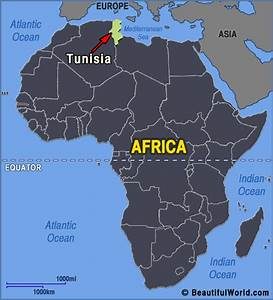
Tunisia – FAST FACTS*
Provided by my friends at Wikipedia and others.
Tunisia (officially the Republic of Tunisia) is a country in the Maghreb region of North Africa, covering 163,610 square kilometres (63,170 square miles). Its northernmost point, Cape Angela, is the northernmost point on the African continent. It is bordered by Algeria to the west and southwest, Libya to the southeast, and the Mediterranean Sea to the north and east. Tunisia’s population was 11.435 million in 2017. Tunisia’s name is derived from its capital city, Tunis, which is located on its northeast coast.
Tunisia is a unitary semi-presidential representative democratic republic. It is considered to be the only fully democratic sovereign state in the Arab world. It has a high human development index. It has an association agreement with the European Unionand has obtained the status of major non-NATO ally of the United States. In addition, Tunisia is also a member state of the United Nations.
In ancient times, Tunisia was primarily inhabited by Berbers. Phoenician immigration began in the 12th century BC; these immigrants founded Carthage. A major mercantile power and a military rival of the Roman Republic, Carthage was defeated by the Romans in 146 BC. The Romans, who would occupy Tunisia for most of the next eight hundred years, introduced Christianity and left architectural legacies like the El Djem amphitheater.
After several attempts starting in 647, the Muslims conquered the whole of Tunisia by 697, followed by the Ottoman Empire between 1534 and 1574. The Ottomans held sway for over three hundred years. The French colonization of Tunisia occurred in 1881. Tunisia gained independence with Habib Bourguiba and declared the Tunisian Republic in 1957. In 2011, the Tunisian Revolution resulted in the overthrow of President Zine El Abidine Ben Ali, followed by parliamentary elections. The country voted for parliament again on 26 October 2014, and for President on 23 November 2014.
Etymology
The word Tunisia is derived from Tunis; a central urban hub and the capital of modern-day Tunisia. Before Tunisia, the territory’s name was Ifriqiya or Africa, which gave the present-day name of the continent Africa.
History
Antiquity
Farming methods reached the Nile Valley from the Fertile Crescent region about 5000 BC, and spread to the Maghreb by about 4000 BC. Agricultural communities in the humid coastal plains of central Tunisia then were ancestors of today’s Berber tribes.
It was believed in ancient times that Africa was originally populated by Gaetulians and Libyans, both nomadic peoples. According to the Roman historian Sallust, the demigod Hercules died in Spain and his polyglot eastern army was left to settle the land, with some migrating to Africa. Persians went to the West and intermarried with the Gaetulians and became the Numidians. The Medes settled and were known as Mauri, later Moors.
The Numidians and Moors belonged to the race from which the Berbers are descended. The translated meaning of Numidian is Nomad and indeed the people were semi-nomadic until the reign of Masinissa of the Massyli tribe.
At the beginning of recorded history, Tunisia was inhabited by Berber tribes. Its coast was settled by Phoenicians starting as early as the 12th century BC (Bizerte, Utica). The city of Carthage was founded in the 9th century BC by Phoenicians. Legend says that Dido from Tyre, now in modern-day Lebanon, founded the city in 814 BC, as retold by the Greek writer Timaeus of Tauromenium. The settlers of Carthage brought their culture and religion from Phoenicia, now present-day Lebanon and adjacent areas.
After the series of wars with Greek city-states of Sicily in the 5th century BC, Carthage rose to power and eventually became the dominant civilization in the Western Mediterranean. The people of Carthage worshipped a pantheon of Middle Eastern gods including Baal and Tanit. Tanit’s symbol, a simple female figure with extended arms and long dress, is a popular icon found in ancient sites. The founders of Carthage also established a Tophet, which was altered in Roman times.
A Carthaginian invasion of Italy led by Hannibal during the Second Punic War, one of a series of wars with Rome, nearly crippled the rise of Roman power. From the conclusion of the Second Punic War in 202 BC, Carthage functioned as a client state of the Roman Republic for another 50 years.
Following the Battle of Carthage which began in 149 BC during the Third Punic War, Carthage was conquered by Rome in 146 BC. Following its conquest, the Romans renamed Carthage to Africa, incorporating it as a province.
During the Roman period, the area of what is now Tunisia enjoyed a huge development. The economy, mainly during the Empire, boomed: the prosperity of the area depended on agriculture. Called the Granary of the Empire, the area of actual Tunisia and coastal Tripolitania, according to one estimate, produced one million tons of cereals each year, one-quarter of which was exported to the Empire. Additional crops included beans, figs, grapes, and other fruits.
By the 2nd century, olive oil rivaled cereals as an export item. In addition to the cultivations and the capture and transporting of exotic wild animals from the western mountains, the principal production and exports included the textiles, marble, wine, timber, livestock, pottery such as African Red Slip, and wool.
There was even a huge production of mosaics and ceramics, exported mainly to Italy, in the central area of El Djem (where there was the second biggest amphitheater in the Roman Empire).
Berber bishop Donatus Magnus was the founder of a Christian group known as the Donatists. During the 5th and 6th centuries (from 430 to 533 AD), the Germanic Vandals invaded and ruled over a kingdom in Northwest Africa that included present-day Tripoli. The region was easily reconquered in 533–534 AD, during the rule of Emperor Justinian I, by the Eastern Romans led by General Belisarius.
Middle Ages
Sometime between the second half of the 7th century and the early part of the 8th century, Arab Muslim conquest occurred in the region. They founded the first Islamic city in Northwest Africa, Kairouan. It was there in 670 AD that the Mosque of Uqba, or the Great Mosque of Kairouan, was constructed. This mosque is the oldest and most prestigious sanctuary in the Muslim West with the oldest standing minaret in the world; it is also considered a masterpiece of Islamic art and architecture.
Tunis was taken in 695, re-taken by the Byzantine Eastern Romans in 697, but lost finally in 698. The transition from a Latin-speaking Christian Berber society to a Muslim and mostly Arabic-speaking society took over 400 years (the equivalent process in Egypt and the Fertile Crescent took 600 years) and resulted in the final disappearance of Christianity and Latin in the 12th or 13th centuries. The majority of the population were not Muslim until quite late in the 9th century; a vast majority were during the 10th. Also, some Tunisian Christians emigrated; some richer members of society did so after the conquest in 698 and others were welcomed by Norman rulers to Sicily or Italy in the 11th and 12th centuries – the logical destination because of the 1200 year close connection between the two regions.
The Arab governors of Tunis founded the Aghlabid Dynasty, which ruled Tunisia, Tripolitania and eastern Algeria from 800 to 909. Tunisia flourished under Arab rule when extensive systems were constructed to supply towns with water for household use and irrigation that promoted agriculture (especially olive production). This prosperity permitted luxurious court life and was marked by the construction of new palace cities such as al-Abassiya (809) and Raqadda (877).
After conquering Cairo, the Fatimids abandoned Tunisia and parts of Eastern Algeria to the local Zirids (972–1148). Zirid Tunisia flourished in many areas: agriculture, industry, trade, and religious and secular learning. Management by the later Zirid emirs was neglectful though, and political instability was connected to the decline of Tunisian trade and agriculture.
The depredation of the Tunisian campaigns by the Banu Hilal, a warlike Arab Bedouin tribe encouraged by the Fatimids of Egypt to seize Northwest Africa, sent the region’s rural and urban economic life into further decline. Consequently, the region underwent rapid urbanisation as famines depopulated the countryside and industry shifted from agriculture to manufactures. The Arab historian Ibn Khaldun wrote that the lands ravaged by Banu Hilal invaders had become completely arid desert.
The main Tunisian cities were conquered by the Normans of Sicily under the Kingdom of Africa in the 12th century, but following the conquest of Tunisia in 1159–1160 by the Almohads the Normans were evacuated to Sicily. Communities of Tunisian Christians would still exist in Tunisia up to the 14th century. The Almohads initially ruled over Tunisia through a governor, usually a near relative of the Caliph. Despite the prestige of the new masters, the country was still unruly, with continuous rioting and fighting between the townsfolk and wandering Arabs and Turks, the latter being subjects of the Muslim Armenian adventurer Karakush. Also, Tunisia was occupied by Ayyubidsbetween 1182 and 1183 and again between 1184 and 1187.
The greatest threat to Almohad rule in Tunisia was the Banu Ghaniya, relatives of the Almoravids, who from their base in Mallorca tried to restore Almoravid rule over the Maghreb. Around 1200 they succeeded in extending their rule over the whole of Tunisia until they were crushed by Almohad troops in 1207. After this success, the Almohads installed Walid Abu Hafs as the governor of Tunisia. Tunisia remained part of the Almohad state, until 1230 when the son of Abu Hafs declared himself independent. During the reign of the Hafsid dynasty, fruitful commercial relationships were established with several Christian Mediterranean states. In the late 16th century the coast became a piratestronghold
Ottoman Tunisia
In the last years of the Hafsid dynasty, Spain seized many of the coastal cities, but these were recovered by the Ottoman Empire.
The first Ottoman conquest of Tunis took place in 1534 under the command of Barbarossa Hayreddin Pasha, the younger brother of Oruç Reis, who was the Kapudan Pasha of the Ottoman Fleet during the reign of Suleiman the Magnificent. However, it wasn’t until the final Ottoman reconquest of Tunis from Spain in 1574 under Kapudan Pasha Uluç Ali Reis that the Ottomans permanently acquired the former Hafsid Tunisia, retaining it until the French conquest of Tunisia in 1881.
Initially under Turkish rule from Algiers, soon the Ottoman Porte appointed directly for Tunis a governor called the Pasha supported by janissary forces. Before long, however, Tunisia became in effect an autonomous province, under the local Bey. Under its Turkish governors, the Beys, Tunisia attained virtual independence. The Hussein dynasty of Beys, established in 1705, lasted until 1957. This evolution of status was from time to time challenged without success by Algiers. During this era the governing councils controlling Tunisia remained largely composed of a foreign elite who continued to conduct state business in the Turkish language.
Attacks on European shipping were made by corsairs, primarily from Algiers, but also from Tunis and Tripoli, yet after a long period of declining raids the growing power of the European states finally forced its termination. Under the Ottoman Empire, the boundaries of Tunisia contracted; it lost territory to the west (Constantine) and to the east (Tripoli).
Great epidemics ravaged Tunisia in 1784–1785, 1796–1797 and 1818–1820.
In the 19th century, the rulers of Tunisia became aware of the ongoing efforts at political and social reform in the Ottoman capital. The Bey of Tunis then, by his own lights but informed by the Turkish example, attempted to effect a modernizing reform of institutions and the economy. Tunisian international debt grew unmanageable. This was the reason or pretext for French forces to establish a protectorate in 1881.
French Tunisia (1881–1956)
In 1869, Tunisia declared itself bankrupt and an international financial commission took control over its economy. In 1881, using the pretext of a Tunisian incursion into Algeria, the French invaded with an army of about 36,000 and forced the Bey to agree to the terms of the 1881 Treaty of Bardo (Al Qasr as Sa’id). With this treaty, Tunisia was officially made a French protectorate, over the objections of Italy. Under French colonization, European settlements in the country were actively encouraged; the number of French colonists grew from 34,000 in 1906 to 144,000 in 1945. In 1910 there were 105,000 Italians in Tunisia.
During World War II, French Tunisia was ruled by the collaborationist Vichy government located in Metropolitan France. The antisemitic Statute on Jews enacted by the Vichy was also implemented in Vichy Northwest Africa and overseas French territories. Thus, the persecution, and murder of the Jews from 1940 to 1943 was part of the Shoah in France.
From November 1942 until May 1943, Vichy Tunisia was occupied by Nazi Germany. SS Commander Walter Rauff continued to implement the Final Solution there. From 1942–1943, Tunisia was the scene of the Tunisia Campaign, a series of battles between the Axis and Allied forces. The battle opened with initial success by the German and Italian forces, but the massive supply and numerical superiority of the Allies led to the Axis surrender on 13 May 1943.
Post-independence (1956–2011)
Tunisia achieved independence from France on March 20, 1956 with Habib Bourguiba as Prime Minister. March 20 is celebrated annually as Tunisian Independence Day. A year later, Tunisia was declared a republic, with Bourguiba as the first President. From independence in 1956 until the 2011 revolution, the government and the Constitutional Democratic Rally (RCD), formerly Neo Destour and the Socialist Destourian Party, were effectively one. Following a report by Amnesty International, The Guardian called Tunisia “one of the most modern but repressive countries in the Arab world”.
In November 1987, doctorsdeclared Bourguiba unfit to rule and, in a bloodless coup d’état, Prime Minister Zine El Abidine Ben Ali assumed the presidency in accordance with Article 57 of the Tunisian constitution. The anniversary of Ben Ali’s succession, 7 November, was celebrated as a national holiday. He was consistently re-elected with enormous majorities every five years (well over 80 percent of the vote), the last being 25 October 2009, until he fled the country amid popular unrest in January 2011.
Ben Ali and his family were accused of corruption and plundering the country’s money. Economic liberalisation provided further opportunities for financial mismanagement, while corrupt members of the Trabelsi family, most notably in the cases of Imed Trabelsi and Belhassen Trabelsi, controlled much of the business sector in the country. The First Lady Leila Ben Ali was described as an “unabashed shopaholic” who used the state airplane to make frequent unofficial trips to Europe’s fashion capitals. Tunisia refused a French request for the extradition of two of the President’s nephews, from Leila’s side, who were accused by the French State prosecutor of having stolen two mega-yachts from a French marina. Ben Ali’s son-in-law Sakher El Materi was rumoured as being primed to eventually take over the country.
Independent human rights groups, such as Amnesty International, Freedom House, and Protection International, documented that basic human and political rights were not respected. The regime obstructed in any way possible the work of local human rights organizations. In 2008, in terms of Press freedom, Tunisia was ranked 143rd out of 173.
Post-revolution (since 2011)
The Tunisian Revolution was an intensive campaign of civil resistance that was precipitated by high unemployment, food inflation, corruption, a lack of freedom of speech and other political freedoms and poor living conditions. Labour unions were said to be an integral part of the protests. The protests inspired the Arab Spring, a wave of similar actions throughout the Arab world.
The catalyst for mass demonstrations was the death of Mohamed Bouazizi, a 26-year-old Tunisian street vendor, who set himself afire on 17 December 2010 in protest at the confiscation of his wares and the humiliation inflicted on him by a municipal official named Faida Hamdy. Anger and violence intensified following Bouazizi’s death on 4 January 2011, ultimately leading longtime President Zine El Abidine Ben Ali to resign and flee the country on 14 January 2011, after 23 years in power.
Protests continued for banning of the ruling party and the eviction of all its members from the transitional government formed by Mohammed Ghannouchi. Eventually the new government gave in to the demands. A Tunis court banned the ex-ruling party RCD and confiscated all its resources. A decree by the minister of the interior banned the “political police”, special forces which were used to intimidate and persecute political activists.
On 3 March 2011, the president announced that elections to a Constituent Assembly would be held on 23 October 2011. International and internal observers declared the vote free and fair. The Ennahda Movement, formerly banned under the Ben Ali regime, won a plurality of 90 seats out of a total of 217. On 12 December 2011, former dissident and veteran human rights activist Moncef Marzouki was elected president.
In March 2012, Ennahda declared it will not support making sharia the main source of legislation in the new constitution, maintaining the secular nature of the state. Ennahda’s stance on the issue was criticized by hardline Islamists, who wanted strict sharia, but was welcomed by secular parties. On 6 February 2013, Chokri Belaid, the leader of the leftist opposition and prominent critic of Ennahda, was assassinated.
In 2014, President Moncef Marzouki established Tunisia’s Truth and Dignity Commission, as a key part of creating a national reconciliation.
Tunisia was hit by two terror attacks on foreign tourists in 2015, first killing 22 people at the Bardo National Museum, and later killing 38 people at the Sousse beachfront. Tunisian president Beji Caid Essebsi renewed the state of emergency in October for three more months.
The Tunisian National Dialogue Quartet won the 2015 Nobel Peace Prize for its work in building a peaceful, pluralistic political order in Tunisia.
Geography
Geography of Tunisia
Tunisia is situated on the Mediterranean coast of Northwest Africa, midway between the Atlantic Ocean and the Nile Delta. It is bordered by Algeria on the west and southwest and Libya on the south east. It lies between latitudes 30° and 38°N, and longitudes 7° and 12°E. An abrupt southward turn of the Mediterranean coast in northern Tunisia gives the country two distinctive Mediterranean coasts, west-east in the north, and north-south in the east.
Though it is relatively small in size, Tunisia has great environmental diversity due to its north-south extent. Its east-west extent is limited. Differences in Tunisia, like the rest of the Maghreb, are largely north-south environmental differences defined by sharply decreasing rainfall southward from any point.
The Sahel, a broadening coastal plain along Tunisia’s eastern Mediterranean coast, is among the world’s premier areas of olive cultivation. Inland from the Sahel, between the Dorsal and a range of hills south of Gafsa, are the Steppes. Much of the southern region is semi-arid and desert.
Tunisia has a coastline 1,148 kilometres (713 mi) long. In maritime terms, the country claims a contiguous zone of 24 nautical miles (44.4 km; 27.6 mi), and a territorial sea of 12 nautical miles (22.2 km; 13.8 mi).
Climate
Tunisia’s climate is Mediterranean in the north, with mild rainy winters and hot, dry summers. The south of the country is desert. The terrain in the north is mountainous, which, moving south, gives way to a hot, dry central plain. The south is semiarid, and merges into the Sahara. A series of salt lakes, known as chotts or shatts, lie in an east-west line at the northern edge of the Sahara, extending from the Gulf of Gabes into Algeria. The lowest point is Chott el Djerid at 17 metres (56 ft) below sea level and the highest is Jebel ech Chambi at 1,544 metres (5,066 ft).
| Climate data for Tunisia in general | |||||||||||||
| Month | Jan | Feb | Mar | Apr | May | Jun | Jul | Aug | Sep | Oct | Nov | Dec | Year |
| Average high °C (°F) | 14.7 (58.5) |
15.7 (60.3) |
17.6 (63.7) |
20.3 (68.5) |
24.4 (75.9) |
28.9 (84.0) |
32.4 (90.3) |
32.3 (90.1) |
29.2 (84.6) |
24.6 (76.3) |
19.6 (67.3) |
15.8 (60.4) |
23.0 (73.3) |
| Average low °C (°F) | 6.4 (43.5) |
6.5 (43.7) |
8.2 (46.8) |
10.4 (50.7) |
13.8 (56.8) |
17.7 (63.9) |
20.1 (68.2) |
20.7 (69.3) |
19 (66) |
15.2 (59.4) |
10.7 (51.3) |
7.5 (45.5) |
13.0 (55.4) |
| Average rainfall mm (inches) | 50.5 (1.99) |
45.3 (1.78) |
43.4 (1.71) |
35.5 (1.40) |
21 (0.8) |
10.8 (0.43) |
3.7 (0.15) |
8.8 (0.35) |
10.5 (0.41) |
38.6 (1.52) |
46.4 (1.83) |
56.4 (2.22) |
370.9 (14.59) |
| Source: Weatherbase[96] | |||||||||||||
Politics
Tunisia is a representative democracy and a republic with a president serving as head of state, prime minister as head of government, a unicameral parliament, and a civil law court system. The Constitution of Tunisia, adopted 26 January 2014, guarantees rights for women and states that the President’s religion “shall be Islam”. In October 2014 Tunisia held its first elections under the new constitution following the Arab Spring.
The number of legalized political parties in Tunisia has grown considerably since the revolution. There are now over 100 legal parties, including several that existed under the former regime. During the rule of Ben Ali, only three functioned as independent opposition parties: the PDP, FDTL, and Tajdid. While some older parties are well-established and can draw on previous party structures, many of the 100-plus parties extant as of February 2012 are small.
Rare for the Arab world, women held more than 20% of seats in the country’s pre-revolution bicameral parliament. In the 2011 constituent assembly, women held between 24% and 31% of all seats.
Tunisia is included in the European Union’s European Neighbourhood Policy (ENP), which aims at bringing the EU and its neighbours closer. On 23 November 2014 Tunisia held its first Presidential Election following the Arab Spring in 2011.
The Tunisian legal system is heavily influenced by French civil law, while the Law of Personal Status is based on Islamic law. Sharia courts were abolished in 1956.
A Code of Personal Status was adopted shortly after independence in 1956, which, among other things, gave women full legal status (allowing them to run and own businesses, have bank accounts, and seek passports under their own authority). The code outlawed the practices of polygamy and repudiation and a husband’s right to unilaterally divorce his wife. Further reforms in 1993 included a provision to allow Tunisian women to transmit citizenship even if they are married to a foreigner and living abroad. The Law of Personal Status is applied to all Tunisians regardless of their religion. The Code of Personal Status remains one of the most progressive civil codes in North Africa and the Muslim world.
Human rights
After the revolution, a number of Salafist groups emerged and in some occasions have violently repressed artistic expression that is viewed to be hostile to Islam.
Homosexuality is illegal in Tunisia and can be punished by up to three years in prison. On 7 December 2016, two Tunisian men were arrested on suspicion of homosexual activity in Sousse. According to 2013 survey by the Pew Research Center, 94% of Tunisians believe that homosexuality should not be accepted by society.
The Tunisian regime has been criticisedfor its policy on recreational drug use, for instance automatic 1-year prison sentences for consuming cannabis. Prisons are crowded and drug offenders represent nearly a third of the prison population.
In 2017, Tunisia became the first Arab country to outlaw domestic violence against women, which was previously not a crime. Also, the law allowing rapists to escape punishment by marrying the victim was abolished. According to Human Rights Watch, 47% of Tunisian women have been subject to domestic violence.
Military
As of 2008, Tunisia had an army of 27,000 personnel equipped with 84 main battle tanks and 48 light tanks. The navy had 4,800 personnel operating 25 patrol boats and 6 other craft. The Tunisian Air Force has 154 aircraft and 4 UAVs. Paramilitary forces consisted of a 12,000-member national guard. Tunisia’s military spending was 1.6% of GDP as of 2006. The army is responsible for national defence and also internal security. Tunisia has participated in peacekeeping efforts in the DROC and Ethiopia/Eritrea. United Nations peacekeeping deployments for the Tunisian armed forces have been in Cambodia (UNTAC), Namibia (UNTAG), Somalia, Rwanda, Burundi, Western Sahara (MINURSO) and the 1960s mission in the Congo, ONUC.
The military has historically played a professional, apolitical role in defending the country from external threats. Since January 2011 and at the direction of the executive branch, the military has taken on increasing responsibility for domestic security and humanitarian crisis response.
Administrative divisions
Economy
Tunisia is an export-oriented country in the process of liberalizing and privatizing an economy that, while averaging 5% GDP growth since the early 1990s, has suffered from corruption benefiting politically connected elites. Tunisia’s Penal Code criminalises several forms of corruption, including active and passive bribery, abuse of office, extortion and conflicts of interest, but the anti-corruption framework is not effectively enforced. However, according to the Corruption Perceptions Index published annually by Transparency International, Tunisia was ranked the least corrupt North-African-country in 2016, with a score of 41. Tunisia has a diverse economy, ranging from agriculture, mining, manufacturing, and petroleum products, to tourism. In 2008 it had a GDP of US$41 billion (official exchange rates), or $82 billion (purchasing power parity).
The agricultural sector accounts for 11.6% of the GDP, industry 25.7%, and services 62.8%. The industrial sector is mainly made up of clothing and footwear manufacturing, production of car parts, and electric machinery. Although Tunisia managed an average 5% growth over the last decade it continues to suffer from a high unemployment especially among youth.
Tunisia was in 2009 ranked the most competitive economy in Africa and the 40th in the world by the World Economic Forum. Tunisia has managed to attract many international companies such as Airbusand Hewlett-Packard.
Tourism accounted for 7% of GDP and 370,000 jobs in 2009.
The European Union remains Tunisia’s first trading partner, currently accounting for 72.5% of Tunisian imports and 75% of Tunisian exports. Tunisia is one of the European Union’s most established trading partners in the Mediterranean region and ranks as the EU’s 30th largest trading partner. Tunisia was the first Mediterranean country to sign an Association Agreement with the European Union, in July 1995, although even before the date of entry came into force, Tunisia started dismantling tariffs on bilateral EU trade. Tunisia finalised the tariffs dismantling for industrial products in 2008 and therefore was the first non-EU Mediterranean country to enter in a free trade area with EU.
Tourism
Among Tunisia’s tourist attractions are its cosmopolitan capital city of Tunis, the ancient ruins of Carthage, the Muslim and Jewish quarters of Jerba, and coastal resorts outside of Monastir. According to The New York Times, Tunisia is “known for its golden beaches, sunny weather and affordable luxuries”.
Energy
Sources of electricity production in Tunisia
Thermal steam (44%)
Combined Cycle (43%)
Gas turbine (11%)
Wind, Hydroelectric, Solar (2%)
The majority of the electricity used in Tunisia is produced locally, by state-owned company STEG (Société Tunisienne de l’Electricité et du Gaz). In 2008, a total of 13,747 GWh was produced in the country.
Oil production of Tunisia is about 97,600 barrels per day (15,520 m3/d). The main field is El Bourma.
Oil production began in 1966 in Tunisia. Currently there are 12 oil fields.
Tunisia had plans for two nuclear power stations, to be operational by 2019. Both facilities are projected to produce 900–1000 MW. France is set to become an important partner in Tunisia’s nuclear power plans, having signed an agreement, along with other partners, to deliver training and technology. As of 2015, Tunisia has abandoned these plans. Instead, Tunisia is considering other options to diversify its energy mix, such as renewable energies, coal, shale gas, liquified natural gas and constructing a submarine power interconnection with Italy.
According to the Tunisian Solar Plan (which is Tunisia’s Renewable Energy Strategy not limited to solar, contrary to what its title may suggest, proposed by the National Agency for Energy Conservation), Tunisia’s objective is to reach a share of 30% of renewable energies in the electricity mix by 2030, most of which should be accounted for by wind power and photovoltaics. As of 2015, Tunisia had a total renewable capacity of 312 MW (245 MW wind, 62 MW hydropower, 15 MW photovoltaics.)
Transport
Transport in Tunisia
The country maintains 19,232 kilometres (11,950 mi) of roads, with three highways: the A1 from Tunis to Sfax (works ongoing for Sfax-Libya), A3 Tunis-Beja (works ongoing Beja – Boussalem, studies ongoing Boussalem – Algeria) and A4 Tunis – Bizerte.
There are 29 airports in Tunisia, with Tunis Carthage International Airport and Djerba–Zarzis International Airport being the most important ones. A new airport, Enfidha – Hammamet International Airport opened in 2011. The airport is located north of Sousse at Enfidha and is to mainly serve the resorts of Hamammet and Port El Kantaoui, together with inland cities such as Kairouan.
Five airlines are headquartered in Tunisia: Tunisair, Syphax airlines, Karthago Airlines, Nouvelair, and Tunisair Express. The railway network is operated by SNCFT and amounts to 2,135 kilometres (1,327 mi) in total. The Tunis area is served by a Light rail network named Metro Leger which is managed by Transtu.
Water supply and sanitation
Tunisia has achieved the highest access rates to water supply and sanitation services in the Middle East and North Africa. As of 2011, access to safe drinking water became close to universal approaching 100% in urban areas and 90% in rural areas. Tunisia provides good quality drinking water throughout the year.
Demographics
Demographics of Tunisia
According to the CIA, as of 2017, Tunisia has a population of 11,403,800 inhabitants. The government has supported a successful family planning program that has reduced the population growth rate to just over 1% per annum, contributing to Tunisia’s economic and social stability.
Ethnic groups
According to CIA The World Factbook, ethnic groups in Tunisia are: Arab 98%, European 1%, Jewish and other 1%.
According to the 1956 Tunisian census, Tunisia had a population at the time of 3,783,000 residents, of which mainly Berbers and Arabs. The proportion of speakers of Berber dialects was at 2% of the population. According to another source the population of Arabs is estimated to be <40%to 98%, and that of Berbers at 1% to over 60%.
From the late 19th century to after World War II, Tunisia was home to large populations of French and Italians (255,000 Europeans in 1956), although nearly all of them, along with the Jewish population, left after Tunisia became independent. The history of the Jews in Tunisia goes back some 2,000 years. In 1948 the Jewish population was an estimated 105,000, but by 2013 only about 900 remained.
The first people known to history in what is now Tunisia were the Berbers. Numerous civilizations and peoples have invaded, migrated to, or have been assimilated into the population over the millennia, with influences of population from Phoenicians/Carthaginians, Romans, Vandals, Arabs, Spaniards, Ottoman Turks and Janissaries, and French. There was a continuing inflow of nomadic Arab tribes from Arabia.
Languages
Languages of Tunisia
Arabic is the official language, and Tunisian Arabic, known as Tounsi, is the national, vernacular variety of Arabic and is used by the public. There is also a small minority of speakers of Berber languages known collectively as Jebbali or Shelha.
French also plays a major role in Tunisian society, despite having no official status. It is widely used in education (e.g., as the language of instruction in the sciences in secondary school), the press, and business. In 2010, there were 6,639,000 French-speakers in Tunisia, or about 64% of the population.Italian is understood and spoken by a small part of the Tunisian population. Shop signs, menus and road signs in Tunisia are generally written in both Arabic and French.
Religion
| Tunisia Religions | ||||
| Islam | 98% | |||
| Judaism | 1% | |||
| other/unknown | 1% | |||
Religion in Tunisia
The majority of Tunisia’s population (around 98%) are Muslims while about 2% follow Christianity and Judaism or other religions. The bulk of Tunisians belong to the Maliki School of Sunni Islam and their mosques are easily recognizable by square minarets. However, the Turks brought with them the teaching of the Hanafi School during the Ottoman rule, which still survives among the Turkish descended families today, and their mosques traditionally have octagonal minarets. Sunnis form the majority with non-denominational Muslims being the second largest group of Muslims, followed by Ibadite Amazighs.
Tunisia has a sizable Christian community of around over 25,000 adherents, mainly Catholics (22,000) and to a lesser degree Protestants. Berber Christians continued to live in Tunisia up until the early 15th century. International Religious Freedom Report for 2007 estimates thousands of Tunisian Muslims have converted to Christianity. Judaism is the country’s third largest religion with 900 members. One-third of the Jewish population lives in and around the capital. The remainder lives on the island of Djerba with 39 synagogues where the Jewish community dates back 2,500 years, on Sfax and Hammam-Lif.
The constitution declares Islam as the official state religion and requires the President to be Muslim. Aside from the president, Tunisians enjoy a significant degree of religious freedom, a right enshrined and protected in its constitution, which guarantees the freedom of thoughts, beliefs and to practice one’s religion.
The country has a secular culture where religion is separated from not only political, but in public life. During the pre-revolution era there were at some point restrictions in the wearing of Islamic head scarves (hijab) in government offices and on public streets and public gatherings. The government believed the hijab is a “garment of foreign origin having a partisan connotation”. There were reports that the Tunisian police harassed men with “Islamic” appearance (such as those with beards), detained them, and sometimes compelled men to shave their beards off.
In 2006, the former Tunisian president declared that he would “fight” the hijab, which he refers to as “ethnic clothing”. Mosques were restricted from holding communal prayers or classes. After the revolution however, a moderate Islamist government was elected leading to more freedom in the practice of religion. It has also made room for the rise of fundamentalist groups such as the Salafists, who call for a strict interpretation of Sharia law. The fall in favour of the moderate Islamist government of Ennahdha was partly due to that, modern Tunisian governments intelligence objectives are to suppress fundamentalist groups before they can pass to act.
Individual Tunisians are tolerant of religious freedom and generally do not inquire about a person’s personal beliefs. Those who violate the rules of work and eating during the Islamic month of Ramadan may be arrested and jailed.
In 2017 a handful of men were arrested for eating in public during Ramadan; they were convicted of committing “a provocative act of public indecency” and sentenced to month-long jail sentences. The state in Tunisia has a role as a “guardian of religion” which was used to justify the arrests.
Education
The total adult literacy rate in 2008 was 78% and this rate goes up to 97.3% when considering only people from 15 to 24 years old. Education is given a high priority and accounts for 6% of GNP. A basic education for children between the ages of 6 and 16 has been compulsory since 1991. Tunisia ranked 17th in the category of “quality of the [higher] educational system” and 21st in the category of “quality of primary education” in The Global Competitiveness Report 2008-9, released by The World Economic Forum.
While children generally acquire Tunisian Arabic at home, when they enter school at age 6, they are taught to read and write in Standard Arabic. From the age of 7, they are taught French while English is introduced at the age of 8.
The four years of secondary education are open to all holders of Diplôme de Fin d’Etudes de l’Enseignement de Base where the students focus on entering university level or join the workforce after completion. The Enseignement secondaire is divided into two stages: general academic and specialized. The higher education system in Tunisia has experienced a rapid expansion and the number of students has more than tripled over the past 10 years from approximately 102,000 in 1995 to 365,000 in 2005. The gross enrollment rate at the tertiary level in 2007 was 31 percent, with gender parity index of GER of 1.5.
Health
Health in Tunisia
In 2010, spending on healthcare accounted for 3.37% of the country’s GDP. In 2009, there were 12.02 physicians and 33.12 nurses per 10,000 inhabitants. The life expectancy at birth was 75.73 years in 2016, or 73.72 years for males and 77.78 years for females. Infant mortality in 2016 was 11.7 per 1,000.
Culture
Culture of Tunisia
The culture of Tunisia is mixed due to its long established history of outside influence from people ‒ such as Phoenicians, Romans, Vandals, Byzantines, Arabs, Turks, Italians, Spaniards, and the French ‒ who all left their mark on the country.
Painting
The birth of Tunisian contemporary painting is strongly linked to the School of Tunis, established by a group of artists from Tunisia united by the desire to incorporate native themes and rejecting the influence of Orientalist colonial painting. It was founded in 1949 and brings together French and Tunisian Muslims, Christians and Jews. Pierre Boucherle was its main instigator, along with Yahia Turki, Abdelaziz Gorgi, Moses Levy, Ammar Farhat, and Jules Lellouche. Given its doctrine, some members have therefore turned to the sources of aesthetic Arab-Muslim art: such as miniature Islamic architecture, etc. Expressionist paintings by Amara Debbache, Jellal Ben Abdallah, and Ali Ben Salem are recognized while abstract art captures the imagination of painters like Edgar Naccache, Nello Levy, and Hedi Turki.
There are currently fifty art galleries housing exhibitions of Tunisian and international artists. These galleries include Gallery Yahia in Tunis and Carthage Essaadi gallery.
Literature
Tunisian literature exists in two forms: Arabic and French. Arabic literature dates back to the 7th century with the arrival of Arab civilization in the region. It is more important in both volume and value than French literature, introduced during the French protectorate from 1881.
Music
At the beginning of the 20th century, musical activity was dominated by the liturgical repertoire associated with different religious brotherhoods and secular repertoire which consisted of instrumental pieces and songs in different Andalusian forms and styles of origins, essentially borrowing characteristics of musical language. In 1930 “The Rachidia” was founded well known thanks to artists from the Jewish community. The founding in 1934 of a musical school helped revive Arab Andalusian music largely to a social and cultural revival led by the elite of the time who became aware of the risks of loss of the musical heritage and which they believed threatened the foundations of Tunisian national identity. The institution did not take long to assemble a group of musicians, poets, scholars. The creation of Radio Tunis in 1938 allowed musicians a greater opportunity to disseminate their works.
Notable Tunisian musicians include Saber Rebaï, Dhafer Youssef, Belgacem Bouguenna, Sonia M’barek and Latifa, Salah El Mahdi, Anouar Brahem, and Lotfi Bouchnak.
Media
The TV media has long remained under the domination of the Establishment of the Broadcasting Authority Tunisia (ERTT) and its predecessor, the Tunisian Radio and Television, founded in 1957. On 7 November 2006, President Zine el-Abidine Ben Ali announced the demerger of the business, which became effective on 31 August 2007. Until then, ERTT managed all public television stations (Télévision Tunisienne 1 as well as Télévision Tunisienne 2 which had replaced the defunct RTT 2) and four national radio stations (Radio Tunis, Tunisia Radio Culture, Youth and Radio RTCI) and five regional Sfax, Monastir, Gafsa, Le Kef and Tataouine. Most programs are in Arabic but some are in French. Growth in private sector radio and television broadcasting has seen the creation of numerous operations including Radio Mosaique FM, Jawhara FM, Zaytuna FM, Hannibal TV, Ettounsiya TV, and Nessma TV.
In 2007, some 245 newspapers and magazines (compared to only 91 in 1987) are 90% owned by private groups and independents. The Tunisian political parties have the right to publish their own newspapers, but those of the opposition parties have very limited editions (like Al Mawkif or Mouwatinoun). Before the recent democratic transition, although freedom of the press was formally guaranteed by the constitution, almost all newspapers have in practice followed the government line report. Critical approach to the activities of the president, government and the Constitutional Democratic Rally Party (then in power) were suppressed. In essence, the media was dominated by state authorities through the Agence Tunis Afrique Presse. This has changed since, as the media censorship by the authorities have been largely abolished, and self-censorship has significantly decreased. Nonetheless, the current regulatory framework and social and political culture mean that the future of press and media freedom is still unclear.
Sports
Football is the most popular sport in Tunisia. The Tunisia national football team, also known as “The Eagles of Carthage,” won the 2004 African Cup of Nations (ACN), which was held in Tunisia. They also represented Africa in the 2005 FIFA Cup of Confederations, which was held in Germany, but they could not go beyond the first round.
The premier football league is the “Tunisian Ligue Professionnelle 1”. The main clubs are Espérance Sportive de Tunis, Étoile Sportive du Sahel, Club Africain, Club Sportif Sfaxien and EGS Gafsa.
The Tunisia national handball team has participated in several handball world championships. In 2005, Tunisia came fourth. The national league consists of about 12 teams, with ES. Sahel and Esperance S.Tunis dominating. The most famous Tunisian handball player is Wissem Hmam. In the 2005 Handball Championship in Tunis, Wissem Hmam was ranked as the top scorer of the tournament. The Tunisian national handball team won the African Cup ten times, being the team dominating this competition. The Tunisians won the 2018 African Cup in Gabon by defeating Egypt.
In recent years, Tunisia’s national basketball team has emerged as a top side in Africa. The team won the 2011 Afrobasket and hosted Africa’s top basketball event in 1965, 1987 and 2015.
In boxing, Victor Perez (“Young”) was world champion in the flyweight weight class in 1931 and 1932.
In the 2008 Summer Olympics, Tunisian Oussama Mellouli won a gold medal in 1,500 metres (4,900 feet) freestyle. In the 2012 Summer Olympics, he won a bronze medal in the 1,500 metres (4,900 feet) freestyle and a gold medal in the 15 kilometres (9.3 miles) marathon.
In 2012, Tunisia participated for the seventh time in her history in the Summer Paralympic Games. She finished the competition with 19 medals; 9 golds, 5 silvers and 5 bronzes. Tunisia was classified 14th on the Paralympics medal table and 5th in Athletics.
Tunisia was suspended from Davis Cup play for the year 2014, because the Tunisian Tennis Federation was found to have ordered Malek Jaziri not to compete against an Israeli tennis player, Amir Weintraub. ITF president Francesco Ricci Bitti said: “There is no room for prejudice of any kind in sport or in society. The ITF Board decided to send a strong message to the Tunisian Tennis Federation that this kind of action will not be tolerated.”
That’s all folks! Official end of the RLR – Randy Lewis Racing Trackchaser Report
This recognizes the people I met in Tunisia. It is true. Tunisian hospitality rocks!
.
.
When my trip to Tunisia was finished I traveled to Paris, France. There I met with Fahem Mohamed Ali. He is a Tunisian native and former driver on the Tunisian racing circuit. Fahem wanted to do an interview with me regarding my recent trackchasing visit to his home country. We did the interview in a Paris restaurant. Fahem had several questions to ask. I hope you enjoy the interview.
.
.
From the continent of Africa….from the country of Tunisia…..it’s racing at the Belvedere Circuit
Click on the links below

The trip to Tunisia…Part 1…Touring
.
.
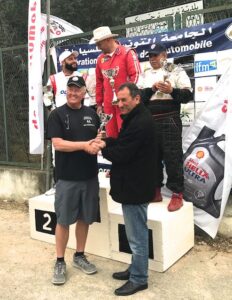
The trip to Tunisia…Part 2…Racing and some more touring
